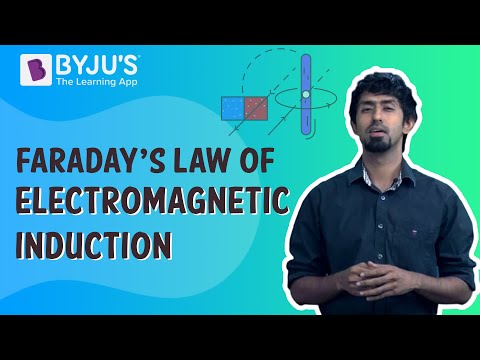In this section, we will learn about the experiments carried out by Faraday and Henry that are used to understand the phenomenon of electromagnetic induction and its properties.
Experiment 1:

In this experiment, Faraday connected a coil to a galvanometer, as shown in the figure above. A bar magnet was pushed towards the coil, such that the north pole is pointing towards the coil. As the bar magnet is shifted, the pointer in the galvanometer gets deflected, thus indicating the presence of current in the coil under consideration. It is observed that when the bar magnet is stationary, the pointer shows no deflection and the motion lasts only till the magnet is in motion. Here, the direction of the deflection of the pointer depends upon the direction of motion of the bar magnet. Also, when the south pole of the bar magnet is moved towards or away from the coil, the deflections in the galvanometer are opposite to that observed with the north-pole for similar movements. Apart from this, the deflection of the pointer is larger or smaller depending upon the speed with which it is pulled towards or away from the coil. The same effect is observed when instead of the bar magnet, the coil is moved and the magnet is held stationary. This shows that only the relative motion between the magnet and the coil are responsible for the generation of current in the coil.
Experiment 2:

In the second experiment, Faraday replaced the bar magnet by a second current-carrying coil that was connected to a battery. Here, the current in the coil due to the connected battery produced a steady magnetic field, which made the system analogous to the previous one. As we move the second coil towards the primary coil, the pointer in the galvanometer undergoes deflection, which indicates the presence of the electric current in the first coil. Similar to the above case, here too, the direction of the deflection of the pointer depends upon the direction of motion of the secondary coil towards or away from the primary coil. Also, the magnitude of deflection depends upon the speed with which the coil is moved. All these results show that the system in the second case is analogous to the system in the first experiment.
Experiment 3:

From the above two experiments, it was concluded by Faraday that the relative motion between the magnet and the coil resulted in the generation of current in the primary coil. But another experiment conducted by Faraday proved that the relative motion between the coils was not really necessary for the current in the primary to be generated. In this experiment, he placed two stationary coils and connected one of them to the galvanometer and the other to a battery, through a push-button. As the button was pressed, the galvanometer in the other coil showed a deflection, indicating the presence of current in that coil. Also, the deflection in the pointer was temporary and if pressed continuously, the pointer showed no deflection and when the key was released, the deflection occurred in the opposite direction.

Frequently Asked Questions – FAQs
What is electromagnetic induction?
What is a galvanometer?
Galvanometer is a instrument for measuring a small electrical current.
What is the formula to find the ?
Where,
- Φ – the amount of magnetic field at a surface
- N is the number of turns in the coil
- t – time
- e – induced voltage (in volts)
Who discovered electromagnetic induction?
AC generators works on which principle?
What does Faraday’s First Law of Electromagnetic Induction state?
The below videos help to revise the chapter Magnetic Effects of Electric Current Class 10
 |
 |
Stay tuned with BYJU’S to learn more about the experiments by Faraday and Henry, relative motion, and much more. Also, register to “BYJU’S – The Learning App” for loads of interactive, engaging Physics-related videos and unlimited academic assistance.

So good
Well explained!!